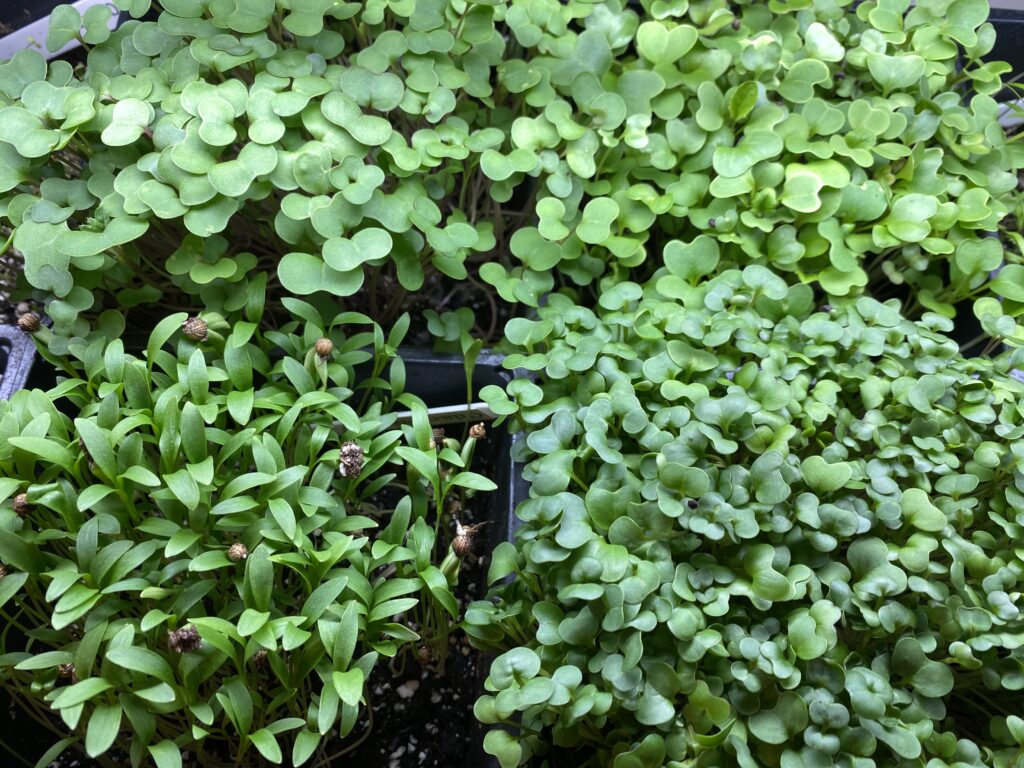
At the risk of being redundant, I thought I’d offer a few tips on growing microgreens.
If you don’t know what microgreens are, where have you been? Oops, that was not a polite sentence, not at all. Let’s try again.
If you don’t know what microgreens are, I wrote an article about them for Family Handyman which offers an explanation.
That’s still not a nice way to provide an explanation, making you go to another link like that.
One more time.
Microgreens are the edible seedlings of many of the vegetables and greens we grow in the garden. They are packed with nutrients and quite easy to grow. I’ve been growing them for several winters now and have a few tips to share.
Tip no. 1 is buy seeds labeled for growing as microgreens because usually these packets will have more seeds in them and you will need more seeds (see above how densely planted those seeds are?). Plus, one presumes, hopes, assumes, and otherwise that the seeds labeled for microgreens haven’t been treated with a fungicide or other chemicals. We aren’t eating the seeds but we still don’t what a bunch of chemicals on those seeds.
Tip no. 2 is sow small batches of microgreens when growing them for yourself and your family. I grow each batch in a 5″ x 5″ plastic container with holes in the bottom. I fill it with about a half inch of plain ol’ potting soil (no nutrients or moisture retention stuff added) which I tamp down with a little block of wood, then I sow the seeds on top, tamp down again, mist and are you ready for tip no. 3?
Tip no. 3 is cover the seeds so they don’t get light until they have germinated. They will look all yellow-y, stretchy, and light deprived, because they haven’t gotten any light yet. Uncover them and expose them to light (which in my set up is an LED light) and they’ll green up quickly and continue to grow.
Tip no. 4 is water from the bottom to avoid flattening the seedlings with streams of water from a watering can. All my little trays are sitting in a big tray without holes, so I just add water to that tray and it gets absorbed from below into the soil. Occasionally, I’ll mist them from above with plain water. They grow nicely and now you wonder when should you harvest them?
Tip no. 5 is to harvest no later than when you see the first true leaves. In the picture above, you see mostly seed leaves. I’m just starting to see the true leaves on a few of those, so I’ll be cutting them soon. When I cut them, I cut just above the soil to keep them as clean as possible, then rinse, pat dry, and eat on them on salads mostly. But they can be used to garnish pretty much anything… soups, stews, casseroles and wouldn’t they be fun and look impressive on one of those fancy charcuterie boards that you see everywhere now?
That’s microgreens in a nutshell. I also talked about them in the last episode (season 4, episode 51) of The Gardenangelists podcast. You can listen here:
Or you can find the podcast on any of the usual platforms for podcasts including Apple, Spotify, etc.
(If you want to grow microgreens AND support the podcast, buy your microgreen seeds and supplies from True Leaf Market. That’s an affiliate link and we’ll get a small commission if you use it!)
One final tip. Put your little microgreen farm where you will see it every day so you won’t forget about it!


I had to laugh as I have one Saffron crocus blooming also, so we can pool our harvest and get rich together. Actually my daughter sent me the bulbs in mid September and said they were ready to plant now they came up fine and I have 3 blooms right now with the promise of many more. I’m not sure what to do with the bulbs after they are done. I plan to let them run their course and die back right here in the house and then hold them for next spring. I live in central NY and think my zone may be the same as yours. you grow your Saffron outdoors. Does it come back every year like regular old crocus, is it a fall blooming crocus, and do you leave them in the ground and just mulch them in? I do think my Halloween Hare would love to take a nibble!
Thanks for any thoughts on this,
Patti Teska
I did forward your post on Saffron to my daughter and she really enjoyed it. She had been with an Urban Agriculture program in MO until a job opportunity for her husband came up in Chicago. She is hoping to find a similar program in Chicago.
Patti, thanks for the comment. Think you probably meant to put it on yesterday’s post about saffron. Yes, saffron crocus should come back each year and I have had rabbits nibble on them, especially the foliage. It is a fall blooming crocus. I don’t give it any special treatment! I think our zones are probably pretty close to the same.
Thanks.
Thanks for the tips on growing Microgreens. Now I need to hear how to make them enticing to eat. While I add them to salads, their long somewhat stringy nature leads some folks to moo like a cow while attempting to eat them. Strands of Microgreens stick out of their mouth in ways lettuce, radish or cabbage never do. Yes, it’s mildly amusing but does not encourage eager adoption of microgreen dining by the skeptics. Any suggestions for making them a fine dining experience?
Judy, Chop up those long stems!